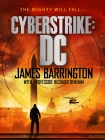Cyberstrike, James Barrington [short story to read .TXT] 📗

- Author: James Barrington
Book online «Cyberstrike, James Barrington [short story to read .TXT] 📗». Author James Barrington
And of course it might not just be a single hacker. Teams or collectives of hackers, like the notorious Anonymous, can pool their resources, their knowledge and their software in order to achieve whatever goals they have set themselves. Thanks to the Internet, these groups of hackers may well have no idea of the identities or locations of the people with whom they are collaborating. And that doesn’t matter to them, because they’re all cut from the same cloth, working together towards what they see as a common purpose or aim.
As the media reports on a regular basis, both individual hackers and loosely organised groups of them have an impressive track record breaching sites in order to steal information, typically a company’s customer database containing their log-ins and credit card details, either to commit financial fraud with the data or to sell the information on the Dark Web, or simply to make a political point by defacing a website. Today, cyberattacks of all sorts are a near-constant threat. One recent study claimed that in America alone there is an attempted hack somewhere in the country every thirty-nine seconds on average, though most of these rarely make the news.
But the people that Sadir had found were very different to this image.
Most hackers are amateurs. They have other jobs or ways of earning a living and their forays into the electronic netherworld of the Dark Web or attacks on government or corporate websites are essentially a hobby. All-consuming, in many cases, but still usually a part-time occupation. And because hacking is a dark art and not the kind of course offered by colleges or universities – ‘computer science’ is about as close as they get – hackers tend to be largely self-taught, learning from other people and downloading and sharing various types of hacking software as their abilities and skill levels increase.
Sadir was neither a programmer nor a hacker, but he knew enough about the subject to avoid trying to recruit the kind of people dismissively known as ‘script kiddies’, the sort of wannabe hackers who would download software they did not understand and use that to mount extremely amateurish attacks. What he had needed were people who were professionally trained – ideally, government trained – and knew exactly what they were doing. He was looking for the sort of people who had put together the Stuxnet virus that had crippled the Iranian nuclear weapon programme by destroying the centrifuges used for the enrichment of uranium at the Natanz facility in central Iran.
With the increasing importance of cybersecurity to combat various forms of cybercrime, almost all governments have seen the necessity to employ both ‘white hat hackers’ to combat cyberattacks and also their own teams of ‘black hat hackers’ who would mount offensive cyber operations. All, of course, completely deniable and off the books. And there was one nation in particular that had refined the art and science of hacking to a high degree and that employed literal armies of highly trained hackers tasked with breaking into websites and intranets and stealing secrets from targeted countries.
One problem was that the ideology of that particular nation was no more in keeping with the aims of radical Islam than it was with the decadent democracies of the West, so an appeal for specialised help on ideological grounds was never going to work. But rather more important than abstract concepts like ideology and philosophy was the appeal of cold hard cash, and that was a weapon Sadir could use to his advantage. And so he had, working through contacts of contacts of contacts until he had finally identified a handful of people with the right qualifications and abilities – they actually had been government trained – and used his financial clout to secure the services of two of them for as long as it took.
And he had offered a bonus: if the scenario played out as Sadir expected it to, as well as the balance of their promised funds, he had told them that at the completion of the operation they would also receive a technological gift that would be of incalculable value to their home country. That wasn’t actually going to happen, because Sadir had an entirely different endgame in mind, but the offer was too attractive to be ignored. And so he had obtained access to the specialised skills and abilities that he had needed in the form of two very experienced and professional hackers.
Because what happened at the house in Fairview was the most important part of the plan, he was a fairly frequent visitor, checking on progress and making sure that the two men had everything that they needed. With the implementation date now only a few days away, this visit was the last that he would make to the property before the commencement of the attack.
The area in front of the house had room to park half a dozen cars. Sadir stopped the Honda behind a dark blue SUV and locked it. By the time he got to the main door of the property, it was already open and the two residents were waiting for him on the full-width porch.
Inside, they led him directly through the property to a room at the rear overlooking the garden, a view that had been concealed behind heavy curtains, and which had probably originally been a study or a den but which had been transformed into a computer games room. Or, more accurately, what looked like a computer games room.
Three identical large wood and metal desks had been positioned side by side and touching in the centre of the room. On each was a





Comments (0)